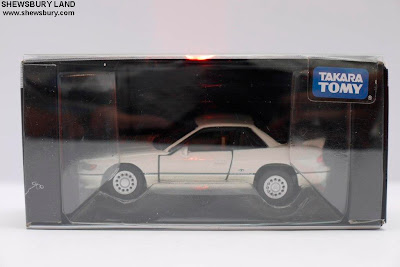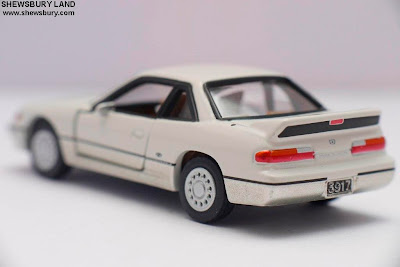Tomica Limited - Nissan Sylvia S13 K's

This is a 1/59 scale die cast car model of Nissan Sylvia S13 (K's) produced by Takara Tomy under their exclusive series of Tomica Limited.
Tomica Limited or shortly known as "TL series" are targeted for the matured collectors. These models are made with higher details, and one of their biggest features is realistic-looking wheels with rubberized plastic tyres. Although many of them are based on existing or discontinued regular Tomica models, some are new castings made exclusively for the TL line.

From Wikipedia:
Nissan Silvia is the name given to the company's long-running line of sport coupes based on the Nissan S platform. Although recent models have shared this chassis with other vehicles produced by Nissan (most notably the European 200SX and North American 240SX in the S13 and S14 generations, and 180SX in the Japanese market), the name Silvia is not interchangeable with the chassis codes.
The S13 Silvia, introduced in mid-1988 for the 1989 model year, was immensely popular in Japan. The Silvia name was no longer used on export models, however; European models were now known as 200SX. In North America, the S13 was known as the 240SX. The Nissan 200SX nameplate would return on a 3 door hatchback version of the B14 Nissan Sentra (1995–99). The S13 was based on the first generation Nissan Cefiro, the A31. Following industry trends, the S13 Silvia switched to relampable fixed headlights. Projector optics were offered as an option.
The S13 Silvia coupe was made from 1988 to 1994, overlapping with the S14 Silvia introduced in 1993. The Nissan Silvia used fixed headlights; whereas, the 180SX, simply a hatchback version of the Silvia, introduced at the same time used pop-up headlights. The 180SX was made until 1998. A Silvia convertible was briefly offered soon after the start of production, but it was never popular, perhaps due to high cost (3.25 million Yen in 1988), heavier curb weight, and chassis flex.
The S13 was one of the first uses of Nissan's multi-link rear suspension, the technology of which was previewed in concept cars in previous years, such as the Nissan MID4. It also offered a four-wheel steering system for the first time, known as HICAS-II. In 1990, HICAS-II was updated and renamed SuperHICAS. The S13 also saw the introduction of a viscous-type limited slip differential for some models.
S13 Silvias were initially powered by the CA18DE and CA18DET engines carried over from the end of S12 production, with an intercooler added to the CA18DET for a slight increase in stability and power. In mid 1990, (for the 1991 model year) the SR20DE and SR20DET engines debuted, offering improvements across the board in power and torque due to increased displacement and a more efficient turbocharger than was offered on the previous cars. One of the other simple changes that was made between the CA generation and the SR generation was the switch to a single colour paint job, instead of the two-tone colour sets that were previously offered. On top of this, the SR motor later debuted another variant of the platform known simply as the "purple top". Identifiable by its black and silver rocker-cover (as opposed to the traditional red/silver cover), it featured a number of minor changes, resulting in little performance gain. It is vastly different to the more powerful "black top" used in the S14 and S15 variants. Amazingly, a revised and revamped version of the Nissan SR20 engine that first appeared in the S13 is still in use today, as can be seen in the following sections of this page.
In the U.S. the S13 was replaced after the 1994 model year by the new S14 design, but lived on till 1999 in Japan with a major face lift, the 180sx Aero (Type X). this was the "Kouki" generation, while the previous was "Chouki" gen. The Kouki featured newly design tail lights a redesigned aero body kit and out fitted with an airbag . In 1998, the S13 Silvia was resurrected, in part. A variant was produced by Kid's Heart for Nissan called the Sileighty, which featured the 180SX body with the front end from the Silvia. The Sileighty style was originally created by Japanese enthusiasts for their own 180SX's, and is still a common modification for the 180SX and 240SX fastback. The Sileighty also made an appearance in a Japanese anime and manga series known as Initial D. The series (based around the Japanese motor sports of Touge and drifting) featured the Sileighty in one of the last battles of the First Stage (or first season in the anime).
The creation of the Sileighty then followed by another version of the Silvia known as the Onevia. Based on the chassis of the S13, the front end of the Silvia would be removed and replaced with the front end of a 180SX. The Onevia was never retailed as a complete car in Japan (though it was in North America: the notchback version of the 240SX was essentially a left hand drive version of the Silvia with the 180SX/240SX nose)
The S13 Silvia was the first S-series car to use the J's, Q's, and K's (references to the face cards of English playing cards) designations for the different trim packages.The J's was the base model . The Q's model offered a slightly more refined experience and received electric options and LSD. The K's grade received the turbocharged CA18DET or SR20DET (depending on the year of manufacture) in addition to the options offered on the Q's.
On top of the K's and Q's models, the Club and Diamond Selection packages came with specific options bundled together. For example, all K's Club Selections came with projector headlamps, a rear spoiler, and 15" aluminum wheels while all Q's models came out with Automatic Climate Control.
The Silvia A's "Almighty" was introduced in late 1992. Trim wise, the Almighty slotted between the J's and Q's, offering options not available on J's, but not including all the standard features of Q's. The only available engine/transmission was the naturally aspirated SR20DE coupled with the 4-speed automatic.
Nissan Silvia is the name given to the company's long-running line of sport coupes based on the Nissan S platform. Although recent models have shared this chassis with other vehicles produced by Nissan (most notably the European 200SX and North American 240SX in the S13 and S14 generations, and 180SX in the Japanese market), the name Silvia is not interchangeable with the chassis codes.
The S13 Silvia, introduced in mid-1988 for the 1989 model year, was immensely popular in Japan. The Silvia name was no longer used on export models, however; European models were now known as 200SX. In North America, the S13 was known as the 240SX. The Nissan 200SX nameplate would return on a 3 door hatchback version of the B14 Nissan Sentra (1995–99). The S13 was based on the first generation Nissan Cefiro, the A31. Following industry trends, the S13 Silvia switched to relampable fixed headlights. Projector optics were offered as an option.
The S13 Silvia coupe was made from 1988 to 1994, overlapping with the S14 Silvia introduced in 1993. The Nissan Silvia used fixed headlights; whereas, the 180SX, simply a hatchback version of the Silvia, introduced at the same time used pop-up headlights. The 180SX was made until 1998. A Silvia convertible was briefly offered soon after the start of production, but it was never popular, perhaps due to high cost (3.25 million Yen in 1988), heavier curb weight, and chassis flex.
The S13 was one of the first uses of Nissan's multi-link rear suspension, the technology of which was previewed in concept cars in previous years, such as the Nissan MID4. It also offered a four-wheel steering system for the first time, known as HICAS-II. In 1990, HICAS-II was updated and renamed SuperHICAS. The S13 also saw the introduction of a viscous-type limited slip differential for some models.
S13 Silvias were initially powered by the CA18DE and CA18DET engines carried over from the end of S12 production, with an intercooler added to the CA18DET for a slight increase in stability and power. In mid 1990, (for the 1991 model year) the SR20DE and SR20DET engines debuted, offering improvements across the board in power and torque due to increased displacement and a more efficient turbocharger than was offered on the previous cars. One of the other simple changes that was made between the CA generation and the SR generation was the switch to a single colour paint job, instead of the two-tone colour sets that were previously offered. On top of this, the SR motor later debuted another variant of the platform known simply as the "purple top". Identifiable by its black and silver rocker-cover (as opposed to the traditional red/silver cover), it featured a number of minor changes, resulting in little performance gain. It is vastly different to the more powerful "black top" used in the S14 and S15 variants. Amazingly, a revised and revamped version of the Nissan SR20 engine that first appeared in the S13 is still in use today, as can be seen in the following sections of this page.
In the U.S. the S13 was replaced after the 1994 model year by the new S14 design, but lived on till 1999 in Japan with a major face lift, the 180sx Aero (Type X). this was the "Kouki" generation, while the previous was "Chouki" gen. The Kouki featured newly design tail lights a redesigned aero body kit and out fitted with an airbag . In 1998, the S13 Silvia was resurrected, in part. A variant was produced by Kid's Heart for Nissan called the Sileighty, which featured the 180SX body with the front end from the Silvia. The Sileighty style was originally created by Japanese enthusiasts for their own 180SX's, and is still a common modification for the 180SX and 240SX fastback. The Sileighty also made an appearance in a Japanese anime and manga series known as Initial D. The series (based around the Japanese motor sports of Touge and drifting) featured the Sileighty in one of the last battles of the First Stage (or first season in the anime).
The creation of the Sileighty then followed by another version of the Silvia known as the Onevia. Based on the chassis of the S13, the front end of the Silvia would be removed and replaced with the front end of a 180SX. The Onevia was never retailed as a complete car in Japan (though it was in North America: the notchback version of the 240SX was essentially a left hand drive version of the Silvia with the 180SX/240SX nose)
The S13 Silvia was the first S-series car to use the J's, Q's, and K's (references to the face cards of English playing cards) designations for the different trim packages.The J's was the base model . The Q's model offered a slightly more refined experience and received electric options and LSD. The K's grade received the turbocharged CA18DET or SR20DET (depending on the year of manufacture) in addition to the options offered on the Q's.
On top of the K's and Q's models, the Club and Diamond Selection packages came with specific options bundled together. For example, all K's Club Selections came with projector headlamps, a rear spoiler, and 15" aluminum wheels while all Q's models came out with Automatic Climate Control.
The Silvia A's "Almighty" was introduced in late 1992. Trim wise, the Almighty slotted between the J's and Q's, offering options not available on J's, but not including all the standard features of Q's. The only available engine/transmission was the naturally aspirated SR20DE coupled with the 4-speed automatic.
And now, let's have a look at this car... first the box/packaging;



And now, out of the box:








The exterior detailing is quite good, exactly as we expect from Tomica Limited series, you can see the "Sylvia" label clearly on the front;

On the side, we can see the "K's" insignia which means this car have the turbo charged engine and also the LSD.

As it says there = TWINCAM TURBO INTERCOOLER

Another "Sylvia" logo/name at the rear;


The other features of this car is the openable doors - on both left/right side;



The interior detailing is just pure minimalist - just like those from Hot Wheels. So far I noted that only a few brands like "Fast Lane", "Masito", "Majorette" and Johnny Lightning did a better job on the interior detailing of their cars. This one is quite boring in fact, I personally disappointed with it but that's how it is, we can get everything all the time...



And that's about it.....


Overall, I'm quite happy with this particular item. The painting finishing and the exterior detailing are quite good, nothing to complain about. The interior detailing is quite simple and minimalist or in other word "sucks". Nonetheless, as a fan of Japanese sports car from the 90's era... I 'm quite happy to have a few unit of of this car. Maybe, if I have the mood, I can try doing some custom paint works on the other units.


Side by side with the Nissan Sylvia S15 at 1/64 scale;

All the Nissan cars in Shewsbury Land at various scale - 1/64, 1/59, 1/60 - mostly at around 3 inches long;

end


Tomica Limited is a really nice option to collect japanese diecast (except for the disappointing interiors) and i’m seriously considering to buy at least one Tomytec for my collection... here in my country, some (B14) Nissan Sentra were/are available but only in the sedan configuration, this Silvia was not seen... and hey, you have a nice collection !!! (and if "you a.k.a. Shewsbury" are more than one person, then you have the advantage over me, because i only have one budget, not two or three =PPPPP)
ReplyDeleteIt's a nice replica with much realism. Good paint work there for a limited line especially the front and side. Those one wordings are impressive. The packaging suited the toy a lot and for a limited toy, the box is well deserving.
ReplyDelete